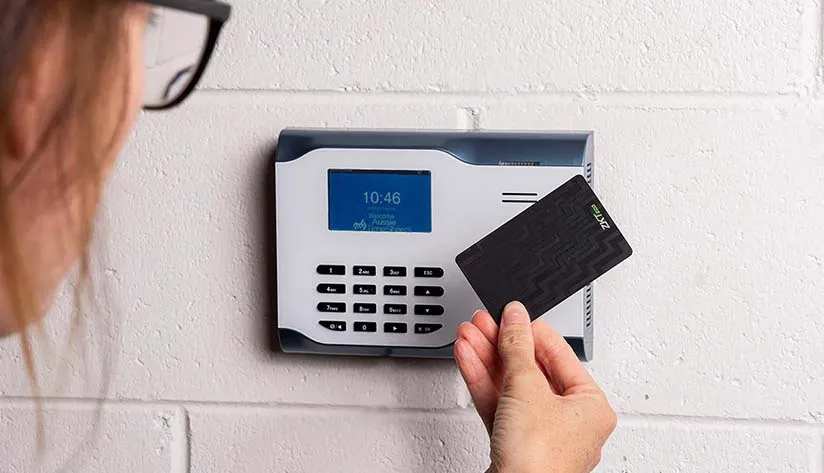In today’s dynamic business landscape, identification cards (ID cards) play a pivotal role that extends far beyond simple employee verification. They are now indispensable tools for enhancing security protocols, optimizing workforce management strategies, and automating a wide array of operational workflows. From regulating access to secure zones to meticulously tracking attendance records and seamlessly integrating with Enterprise Resource Planning (ERP) systems, a well-designed ID card system can significantly improve both efficiency and security.For organizations considering the implementation or enhancement of their ID card systems, a thorough understanding of available technologies, industry best practices, and systematic implementation procedures is crucial. This comprehensive guide provides essential insights into the creation and deployment of effective business ID cards.
1. Advantages of Implementing a Business ID Card System
The implementation of a business ID card system offers benefits that extend beyond basic identification. Let’s examine how an effective ID card system can positively impact your organization.
Enhancing Security
Security is paramount for businesses of all sizes, and a robust ID card system serves as a primary defense against unauthorized access. By integrating ID cards with access control systems, organizations can restrict entry to sensitive areas, ensuring access is limited to authorized personnel. Advanced technologies, such as RFID and smart cards, further strengthen security through real-time authentication and monitoring capabilities. Furthermore, ID cards can be linked to multi-factor authentication systems to mitigate identity fraud and improve overall workplace safety.
Streamlining Employee Management
Efficiently managing employees, visitors, and assets presents a significant challenge for many organizations. An ID card system simplifies this process by enabling automated attendance tracking, visitor registration, and access logging. With features like RFID-enabled tracking, businesses can monitor employee movements within the premises, optimize workspace utilization, and ensure compliance with safety regulations. Moreover, ID cards can be integrated with HR systems, streamlining payroll processing and maintaining accurate employee records.
Improving Operational Efficiency
Automation is essential for reducing manual workloads and improving overall business efficiency. A well-structured ID card system eliminates the need for manual identity verification, accelerates entry processes, and minimizes bottlenecks in both employee and visitor management. Businesses can also utilize ID cards for cashless transactions in cafeterias or vending machines, reducing reliance on physical currency and enhancing convenience. Additionally, by leveraging data from ID card systems, companies can gather valuable insights into workforce behavior, optimize scheduling, and improve overall productivity.
2. Selecting the Appropriate Business ID Card Technology
The successful implementation of a business ID card system hinges on selecting the right technology. A variety of ID card types are available, each offering different levels of security, functionality, and integration capabilities. Understanding these options will enable businesses to choose the most suitable solution for their specific needs.
Common Types of Business ID Card Technologies
Barcode Cards
These are the most basic ID cards, featuring a printed barcode that can be scanned for identification.
- Pros: Cost-effective and easy to implement.
- Cons: Limited security, prone to wear and tear, requires a direct line of sight for scanning.
Magnetic Stripe Cards
These cards contain a magnetic strip that stores employee data, which can be read by swiping the card through a reader.
- Pros: Affordable and widely used in access control and payment systems.
- Cons: Can be easily demagnetized or duplicated, requires physical contact for scanning.
NFC (Near Field Communication) Cards
These allow short-range wireless communication, enabling contactless access control and authentication.
- Pros: Convenient, faster than magnetic stripe or barcode cards, supports encrypted data transmission.
- Cons: More expensive than barcode or magnetic stripe cards, limited range.
RFID (Radio Frequency Identification) Cards
RFID cards utilize radio frequency signals to communicate with readers, allowing seamless, contactless authentication from a distance.
- Pros: Highly secure, supports long-range scanning, enables real-time tracking and multi-application use.
- Cons: Higher initial cost compared to other options.
Why RFID is the Best Choice for Modern Businesses
While barcode, magnetic stripe, and NFC technologies serve specific functions, RFID technology stands out as the most versatile, secure, and future-proof solution for business ID card systems. RFID allows seamless integration with access control, time tracking, cashless payments, and asset management, making it ideal for businesses that prioritize security, automation, and efficiency.
Which Businesses Should Implement RFID ID Cards?
RFID-based business ID cards are especially beneficial for:
- Large Enterprises and Corporate Offices: Enhance security and streamline employee management.
- Manufacturing and Logistics: Enable real-time tracking of personnel and equipment.
- Hospitals and Healthcare Facilities: Ensure secure access to restricted areas and patient data.
- Educational Institutions: Manage student and staff identification, attendance, and facility access.
- Hospitality and Hotels: Provide seamless guest access, staff management, and facilitate cashless transactions.
By choosing RFID ID cards, businesses can future-proof their identification systems, enhance security, and improve operational efficiency.
3. Steps to Implementing a Business ID Card System
Successfully implementing a business ID card system requires a structured approach to ensure seamless integration, security, and efficiency. Below are the key steps businesses should follow:
Step 1: Needs Assessment
Before selecting an ID card system, businesses must evaluate their specific requirements:
- Security Level: Does the company need basic employee identification or high-security access control?
- Business Size: A small office may require a simple ID system, while larger enterprises may need advanced features like real-time tracking and multi-location access.
- Integration Needs: Does the system need to connect with existing access control, payroll, or HR systems?
- Card Functionality: Will the cards be used solely for access control, or should they also support time tracking, payments, or asset management?
Conducting a thorough needs assessment ensures that the selected ID card system aligns with the company’s operational goals.
Step 2: Choosing the Right ID Card System
Once the requirements are clear, businesses should compare different ID card technologies to find the best fit. Options include:
- Basic Photo ID Cards: Suitable for visual identification in low-security environments.
- Magnetic Stripe or Barcode Cards: Ideal for businesses that require basic access control and time tracking.
- NFC and RFID Cards are best for companies that need advanced security, contactless access, and automation features.
For businesses prioritizing security, scalability, and automation, RFID-based ID card systems offer the most comprehensive solution.
Step 3: System Integration and Deployment
After selecting the right ID card technology, the next step is to integrate it with the existing business infrastructure:
- Access Control Systems: Ensure ID cards work with doors, gates, or turnstiles to grant access only to authorized personnel.
- Employee Attendance Tracking: Connect ID cards with time management systems for automated clock-in and clock-out processes.
- HR and Payroll Systems: Integrated with HR platforms to streamline employee records and payroll management.
- Enterprise Resource Planning (ERP) Systems: Large enterprises may require ID cards linked with ERP software for better workforce management.
To ensure smooth deployment, companies should conduct testing before full-scale implementation to identify and resolve any compatibility issues.
Step 4: Employee Training and Implementation
A well-designed ID card system is only effective if employees understand how to use it. Companies should:
- Educate employees on how to use their ID cards for access, attendance tracking, and other functions.
- Train security personnel on how to manage the system and handle lost or stolen ID cards.
- Develop a response plan for potential issues, such as access denials or system failures.
- Monitor and update the system to ensure it continues to meet business needs and security standards.
By following these steps, businesses can seamlessly implement an ID card system that enhances security, improves operational efficiency, and integrates smoothly into their existing workflows.
4. Ensuring Data Security and Privacy Protection
In today’s digital landscape, businesses are increasingly concerned about data security and privacy when implementing ID card systems. Unauthorized access, data breaches, and identity theft are significant risks, especially as ID cards serve more functions than just identification—they integrate with access control, payroll, and even financial transactions. Companies must ensure their ID card systems comply with global privacy regulations while also mitigating potential security threats.
Security Concerns with Business ID Card Systems
When adopting an ID card system, companies often worry about:
- Unauthorized Access: The risk of ID cards being duplicated, stolen, or misused.
- Data Interception: Cybercriminals potentially intercept sensitive employee data during transmission.
- Compliance Issues: Ensuring the system aligns with global privacy laws like GDPR (Europe), CCPA (California), and PCI DSS (financial data standards).
- Employee Privacy: Balancing security with ethical data collection, ensuring personal information is protected.
To address these concerns, businesses need to adopt secure ID card technologies that protect employee and company data.
How RFID Technology Ensures Secure Data Transmission
RFID-based ID card systems provide enhanced security measures compared to traditional magnetic stripe or barcode cards. Here’s how RFID technology helps safeguard business data:
Encrypted Communication: Advanced RFID cards utilize AES-128 encryption to secure the data exchange between the card and the reader, preventing interception and unauthorized cloning.
Unique Identifiers & Anti-Counterfeiting: RFID tags come with unique, non-duplicable serial numbers, making it challenging for unauthorized users to create fake ID cards.Two-factor authentication
(2FA) : Businesses can pair RFID cards with PIN codes, biometrics (fingerprint, facial recognition), or mobile authentication for an extra layer of security.
Restricted Access & Role-Based Permissions: RFID systems allow businesses to assign different access levels based on job roles, ensuring that only authorized employees can access specific areas or data.
Real-Time Monitoring & Alerts: If an unauthorized attempt is detected, the system can trigger alerts, locking access points or notifying security teams in real time.
Compliance with Global Privacy Regulations
To maintain legal compliance and protect user privacy, RFID ID card systems must adhere to several regulations:
GDPR (General Data Protection Regulation – EU) : Ensuring employee data is collected with consent, stored securely, and accessible only to authorized personnel.
CCPA (California Consumer Privacy Act – USA) : Granting employees the right to access, update, or delete their personal data stored within the system.
ISO/IEC 27001: A globally recognized data security standard that businesses can adopt to establish best practices for information security management.
HIPAA (Health Insurance Portability and Accountability Act – USA) : If used in healthcare settings, RFID ID systems must encrypt patient data to ensure compliance with HIPAA regulations.By selecting secure RFID ID card solutions that incorporate encryption, authentication, and real-time security measures, businesses can enhance security, prevent data breaches, and comply with global privacy laws—ensuring both business and employee data remain safe.
5. Common Challenges in Implementing a Business ID Card System
While implementing a business ID card system offers numerous benefits, companies may encounter several common challenges during the adoption process. Understanding these potential roadblocks and choosing the right solutions can ensure a smooth transition to a secure and efficient ID card system.
Higher Initial Cost Compared to Traditional Methods
One of the primary concerns for businesses is the upfront cost associated with implementing an RFID-enabled ID card system. Unlike barcode or magnetic stripe cards, RFID ID cards necessitate additional investment in RFID readers, card encoding technology, and software integration.
Solution: While the initial cost is higher, the long-term benefits far outweigh the investment. RFID technology significantly reduces operational inefficiencies, enhances security, and minimizes administrative workload, ultimately saving businesses time and money in the long run.
Compatibility with Existing Systems
Many businesses operate with legacy systems for access control, payroll, or attendance tracking, raising concerns about whether a new RFID ID card system will integrate seamlessly with these existing frameworks.
Solution: RFIDcard offers a range of RFID ID cards designed for seamless compatibility with existing enterprise management systems. If you’re uncertain about integration, our expert team can assess your current setup and help you implement an RFID ID solution that fully aligns with your existing infrastructure.
Printing Quality Issues with ID Cards
A common frustration for businesses is poor-quality ID card printing. Many suppliers provide RFID cards with uneven surfaces, leading to blurry or inconsistent printing results, which not only look unprofessional but also affect readability and durability.
Solution: RFIDcard’s UltraFlat™ ID Card utilizes advanced manufacturing techniques to create an ultra-smooth card surface, ensuring flawless printing quality. Whether you need high-resolution branding, security holograms, or personalized employee details, our UltraFlat™ ID cards guarantee a crisp, professional finish. We also offer highly customized printing services tailored to your business needs.By addressing these common challenges with the right RFID solutions, businesses can implement a high-performing, scalable, and professional ID card system without compromising on cost-efficiency or quality.
6. Conclusion
Modern ID card solutions, especially RFID-enabled ID cards, offer businesses unparalleled advantages in security, employee management, and operational efficiency. By implementing an advanced ID card system, companies can streamline access control, automate administrative tasks, and enhance overall workforce productivity.
Ready to implement a cutting-edge RFID ID card system? Contact RFIDcard’s expert team today for a customized solution that perfectly fits your business needs. Whether you need high-quality UltraFlat™ RFID ID cards, compatibility assessments, or tailored printing solutions, we’ve got you covered!
FAQs: Frequently Asked Questions
1 How can we ensure our ID card system is scalable?
A well-designed ID card system should be adaptable to your company’s growth. Choosing RFID-enabled ID cards ensures that as your business expands, you can easily add more users, integrate with new access control systems, and support additional security features without overhauling your existing setup.
2 Does the ID card system support multiple authentication methods?
Yes! Modern RFID ID card systems can be integrated with multi-factor authentication (MFA), such as PIN codes, biometric verification (fingerprint or facial recognition), or mobile authentication, for enhanced security.
3 How do we manage and update employee ID card data?
RFID ID cards can be linked to centralized management software, allowing businesses to easily update employee details, access permissions, and security settings in real-time—without needing to reissue new physical cards.
4 What should a company do if an employee loses their ID card?
When the ID card is lost, businesses should:
Immediately deactivate the lost card in the system to prevent unauthorized access.
Issue a replacement card and update security settings accordingly.
Consider implementing RFID-based real-time tracking to detect and prevent potential security breaches.
Recommended Products





RFID Antenna UHF
15-Meter Cable for UHF RFID Fixed Reader
UHF Tag
4″x2″ 860-960MHz UHF RFID Label RFID M4D
UHF Tag
4″x4″UHF RFID Label Alien H3 | ISO18000-6C
RFID Antenna UHF
5-Meter Cable for UHF RFID Fixed Reader
HF Card
ABS RFID KEY-FOB Tag RFID Classic 1K
HF Card
ABS RFID KEY-FOB Tag RFID Classic 4K
HF Card
ABS RFID KEY-FOB Tag RFID Ultralight C
HF Tag
ABS RFID KEY-FOB Tag RFID Ultralight EV1
LF Card
ABS RFID KEY-FOB Tag ATA5577
LF Card
ABS RFID KEY-FOB Tag EM4200
HF Card
ABS RFID KEY-FOB Tag EM4305
HF Card
ABS RFID KEY-FOB Tag RFID TAG 213